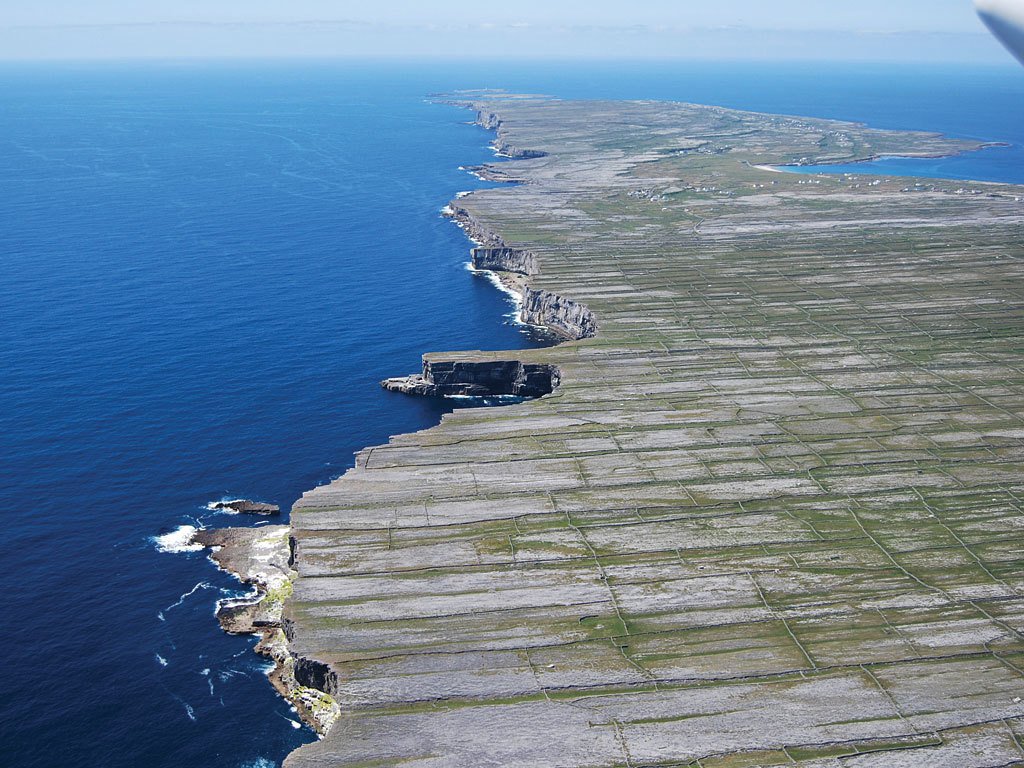The Aran Islands

The Aran Islands (Oileáin Árann – [əlʲˈɑːnʲ ˈɑːrənʲ]) are famous for their geological formation, historical monuments and the rich linguistic and cultural heritage.
On the west coast of ireland, in the mouth of Galway bay, exposed to the harsh weather of the atlantic ocean, lie the Aran Islands. They consist of three Islands: Inishmore (Inis Mór – [ˈiniʃ moːr]), the largest, situated on the west end; Inishmaan (Inis Meáin – [ˈɪnɪɕ mʲɑːn]) the middle island and Inisheer (Inis Oírr – [iniʃ iːrʲ]), the smallest.
The Aran Islands are an extension of the Burren. It is believed that the first settlers inhabited the islands to farm, which was a major challenge given the rocky terrain. Early islanders augmented their soil by hauling seaweed and sand up from the shore.
In the 18th century 5000 people used to live on the islands. The population decreased from then to 1251 in 2011. Until 1975 there was no electrical supply for the islands and until the middle of the 1990s fishing remained the greatest source of income, but it was then given up. Many former fishermen turned to the rising tourism industry or left the Islands.
The islands were reached by Christianity very early. Early monasteries were founded by St Enda in the 5th century. The remains you are able to witness today date back to the 8th century.
Because of the isolated location of the islands, the islands maintained their own culture well into the 20th century. The islanders remain very proud of their cultural heritage. Even now the main language spoken on the island is Irish, although all inhabitants are able to speak fluent English. The Aran islands’ knitwear is fairly well known. The clothes worn by women consisted of a flannel dress and a crochet scarf while men wore a sleeveless tweed jacket with a woolen belt.
The tourism industry of the island has grown a lot in the past years. Bed and Breakfasts are scattered all over the island as well as pubs and rest aurants.
aurants.
The major attractions are the Stone fortresses from the bronze age, Teampull Bheanáin (picture, left) which is considered the smallest church in the world and is, unlike other churches in europe, built in north-south direction and the ‘seven churches’ (Na Seacht dTeampall) who served as a pilgrimage site on the way to Rome, equally important as Enda’s Monastery at the time.
Dun Aengus is the most famous of the several prehistoric forts on the Aran islands and the biggest attraction on Inishmore. The first construction on this site dates back to 1100BC. The fort consi sts of multiple concentric walls of dry stone construction, build on a steep cliff above the sea. Reconstructed parts of the wall can clearly be distinguished by the usage of mortar. It is assumed that large parts of the fort have collapsed into the sea due to erosion caused by The Atlantic. The fort might have originally been oval or D-shaped. The location suggests that Dun Aengus primarily had a religious or ceremonial usage. Other theories on its usage range from coastline defense to control over trading highways along the coastline.
sts of multiple concentric walls of dry stone construction, build on a steep cliff above the sea. Reconstructed parts of the wall can clearly be distinguished by the usage of mortar. It is assumed that large parts of the fort have collapsed into the sea due to erosion caused by The Atlantic. The fort might have originally been oval or D-shaped. The location suggests that Dun Aengus primarily had a religious or ceremonial usage. Other theories on its usage range from coastline defense to control over trading highways along the coastline.
Inishmore is the biggest and the only island which can be reached by plane in only eight minutes through Aer Arann from Connemara Airport for only 50€ return. It offers the most tourist attractions of the three islands and is therefore the most frequently visited island by tourists.
There is a bus connection between Galway main station and Connemara Airport. All of the islands can be reached by ferry from Galway for half the price as flying. Once you reach the island, you have the choice of joining a bus tour across the islands or you can rent a bike for the day, which I would advise you to, if you have the time.
Day trips from Dublin to the Aran islands are offered by various travel agencies and cost about 140€. They include the transfer to the island by train, bus and plane, a visit of Dun Aengus, a bus tour across the island and freetime on Inishmore and in Galway. By organising the tour yourself you will be able to save at least 20€.
Despite the high price for a day trip, the rough landscape of the Aran islands is well worth a visit, especially during summer.